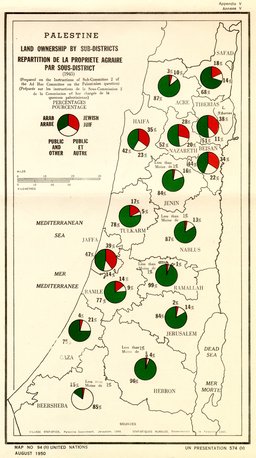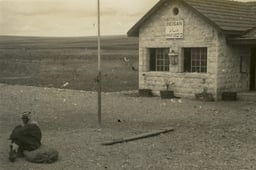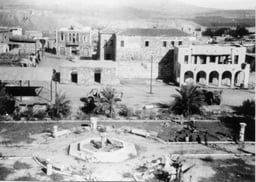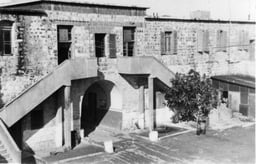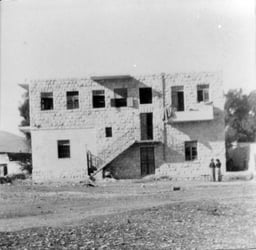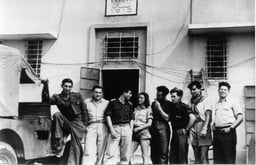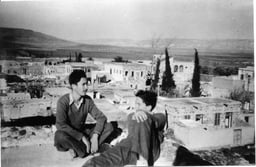Beit She'an
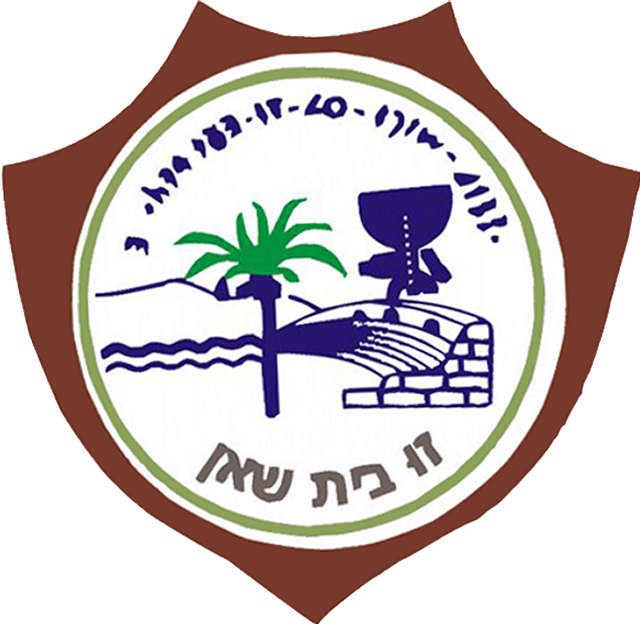
Beit She'an

Beit She'an
| |
|---|---|
| Hebrew transcription(s) | |
| • ISO 259 | Beit Šˀan |
| • Translit. | Bet Šəʼan |
| • Also spelled | Bet She'an (official) Beth Shean (unofficial) |
 Beit She'an Hostel & Guest House | |
| Coordinates:32°30′N 35°30′E [82] | |
| District | Northern |
| Founded | 6th-5th millennia BCE (Earliest settlement) Bronze Age (Canaanite city) |
| Government | |
| • Type | City |
| • Mayor | Jackie Levy |
| Area | |
| • Total | 7,330 dunams (7.33 km2 or 2.83 sq mi) |
| Population (2018)[1] | |
| • Total | 18,227 |
| • Density | 2,500/km2(6,400/sq mi) |
| Name meaning | House of Tranquillity[2] |
| Website | http://www.bet-shean.org.il [83] |
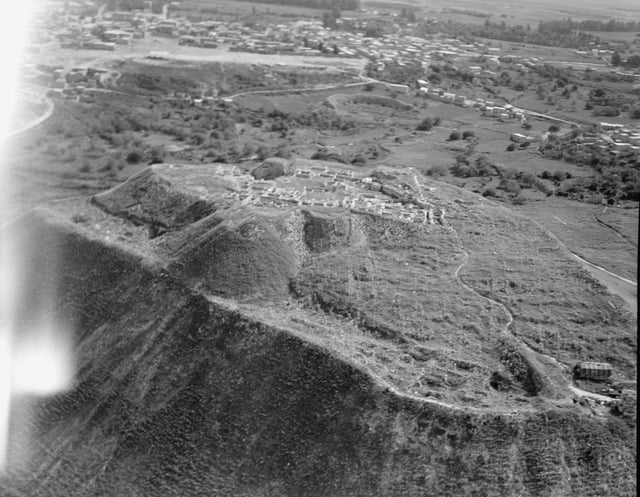
Archaeological excavation in Tell Beit Shen in 1937, the Palestinian town is seen at the top half of the picture
Beit She'an (Hebrew: בֵּית שְׁאָן *Beth Šəān *; Arabic: بيسان Bisān )[2] is a city in the Northern District of Israel which has played an important role in history due to its geographical location at the junction of the Jordan River Valley and the Jezreel Valley. In the Biblical account of the battle of the Israelites against the Philistines on Mount Gilboa,[3] the bodies of King Saul and three of his sons were hung on the walls of Beit She'an (1 Samuel 31:10-12 [84] ).[4] In Roman times, Beit She'an was the leading city of the Decapolis. In modern times, Beit She'an serves as a regional center for the settlements in the Beit She'an Valley.
The ancient city ruins are now protected within the Beit She'an National Park.
Beit She'an
| |
|---|---|
| Hebrew transcription(s) | |
| • ISO 259 | Beit Šˀan |
| • Translit. | Bet Šəʼan |
| • Also spelled | Bet She'an (official) Beth Shean (unofficial) |
 Beit She'an Hostel & Guest House | |
| Coordinates:32°30′N 35°30′E [82] | |
| District | Northern |
| Founded | 6th-5th millennia BCE (Earliest settlement) Bronze Age (Canaanite city) |
| Government | |
| • Type | City |
| • Mayor | Jackie Levy |
| Area | |
| • Total | 7,330 dunams (7.33 km2 or 2.83 sq mi) |
| Population (2018)[1] | |
| • Total | 18,227 |
| • Density | 2,500/km2(6,400/sq mi) |
| Name meaning | House of Tranquillity[2] |
| Website | http://www.bet-shean.org.il [83] |
Geography
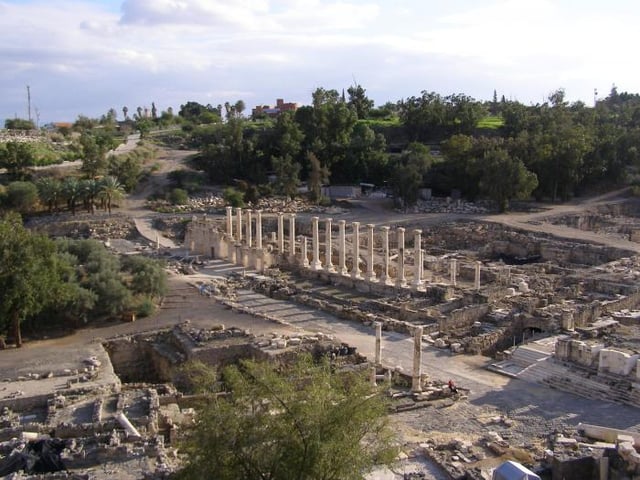
Ancient ruins of Beit She'an
Beit She'an's location has always been strategically significant, due to its position at the junction of the Jordan River Valley and the Jezreel Valley, essentially controlling access from Jordan and the inland to the coast, as well as from Jerusalem and Jericho to the Galilee.
Beit She'an is situated on Highway 90, the north–south road which runs the length of Israel. The city stretches over an area of 7 square kilometers with a substantial national park in the north of the city. Beit She'an has a population of 20,000.[5]
Today the town is under the administration of the Emek HaMa'ayanot Regional Council.
History
Prehistory (Neolithic and Chalcolithic periods)
In 1933, archaeologist G.M. FitzGerald, under the auspices of the University of Pennsylvania Museum, carried out a "deep cut" on Tell el-Hisn ("castle hill"), the large tell, or mound, of Beth She'an, in order to determine the earliest occupation of the site. His results suggest that settlement began in the Late Neolithic or Early Chalcolithic periods (sixth to fifth millennia BCE.)[6] Occupation continued intermittently throughout the Late Neolithic and Chalcolithic periods, with a likely gap during the Late Chalcolithic period.[7]
Bronze Age
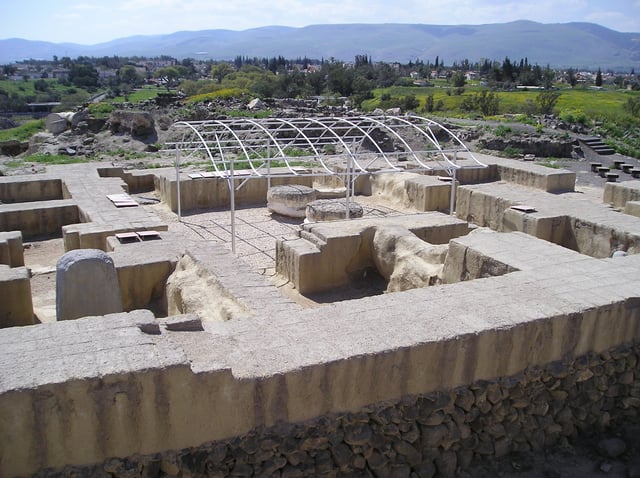
House of the Egyptian governor on Tell el-Husn
Settlement seems to have resumed at the beginning of the Early Bronze Age I (3200–3000) and continues throughout this period, is then missing during Early Bronze Age II, and then resumes in the Early Bronze Age III.[7]
Egyptian period
After the Egyptian conquest of Beit She'an by Pharaoh Thutmose III in the 15th century BCE, as recorded in an inscription at Karnak,[10] the small town on the summit of the mound became the center of the Egyptian administration of the region.[11] The Egyptian newcomers changed the organization of the town and left a great deal of material culture behind. A large Canaanite temple (39 meters in length) excavated by the University of Pennsylvania Museum (Penn Museum) may date from about the same period as Thutmose III's conquest, though the Hebrew University excavations suggest that it dates to a later period.[12] Artifacts of potential cultic significance were found around the temple. Based on a stele found in the temple, inscribed with Egyptian hieroglyphs, the temple was dedicated to the god Mekal.[13] One of the most important finds near the temple is the Lion and Dog stela, currently in the Israel Museum in Jerusalem, which depicts two combat scenes between these two creatures. The Hebrew University excavations determined that this temple was built on the site of an earlier one.[14]
During the three hundred years of Egyptian rule (18th to 20th Dynasty), the population of Beit She'an appears to have been primarily Egyptian administrative officials and military personnel. The town was completely rebuilt, following a new layout, during the 19th dynasty.[15] The Penn Museum excavations uncovered two important stelae from the period of Seti I and a monument of Rameses II.[16] Pottery was produced locally, but some was made to mimic Egyptian forms.[17] Other Canaanite goods existed alongside Egyptian imports, or locally made Egyptian-style objects.[18] The 20th Dynasty saw the construction of large administrative buildings in Beit She'an, including "Building 1500", a small palace for the Egyptian governor.[19] During the 20th Dynasty, invasions of the "Sea Peoples" upset Egypt's control over the Eastern Mediterranean. Though the exact circumstances are unclear, the entire site of Beit She'an was destroyed by fire around 1150 BCE. The Egyptians did not attempt to rebuild their administrative center and finally lost control of the region.
Iron Age
According to the Hebrew Bible, around 1000 BC the town became part of the larger Israelite kingdom under the rule of David and Solomon. 1 Kings 4:12 [85] refers to Beit She'an as part of the kingdom of Solomon, though the historical accuracy of this list is debated.[20] An Iron Age I (1200-1000 BC) Canaanite city was constructed on the site of the Egyptian center shortly after its destruction.[21]
The Assyrian conquest of the northern kingdom of Israel under Tiglath-Pileser III (732 BC) brought about the destruction of Beit She'an by fire.[17]
Minimal reoccupation occurred until the Hellenistic period.[17]
Biblical narrative
According to the Hebrew Bible, around 1100 BCE Canaanite Beit She'an was conquered by the Philistines, who used it as a base of operations for further penetrations into Israel proper. During a subsequent battle against King Saul at nearby Mount Gilboa in 1004 BC, the Philistines prevailed and Saul together with three of his sons, Jonathan, Abinadab and Malchishua, died in battle (1 Samuel 31; 1 Chronicles 10 [86] ). 1 Samuel 31:10 [87] states that "the victorious Philistines hung the body of King Saul on the walls of Beit She'an". King David was able to capture Beit Shea'an in a series of brilliant military campaigns that expelled the Philistines from the area, pushing them back to their southern coastal strongholds.
Hellenistic period

Map of the Decapolis showing the location of Beit She'an, here called by its Greek name, Scythopolis
The Hellenistic period saw the reoccupation of the site of Beit She'an under the new name "Scythopolis" (Ancient Greek: Σκυθόπολις), possibly named after the Scythian mercenaries who settled there as veterans. Little is known about the Hellenistic city, but during the 3rd century BCE a large temple was constructed on the tell.[22] It is unknown which deity was worshipped there, but the temple continued to be used during Roman times. Graves dating from the Hellenistic period are simple, singular rock-cut tombs.[23] From 301 to 198 BCE the area was under the control of the Ptolemies, and Beit She'an is mentioned in 3rd–2nd century BCE written sources describing the Syrian Wars between the Ptolemid and Seleucid dynasties. In 198 BCE the Seleucids finally conquered the region. The town played a role after the Maccabean Revolt: Josephus records that the Jewish High Priest Jonathan was killed there by Demetrius II Nicator.[24] The city was destroyed by fire at the end of the 2nd century BCE.[25]
Roman period
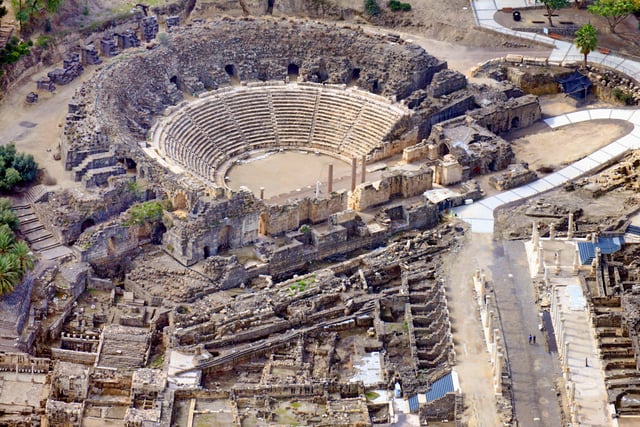
The Roman theatre
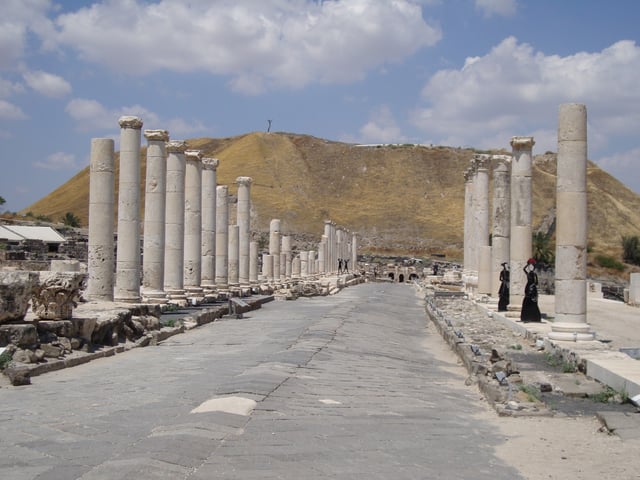
Roman cardo
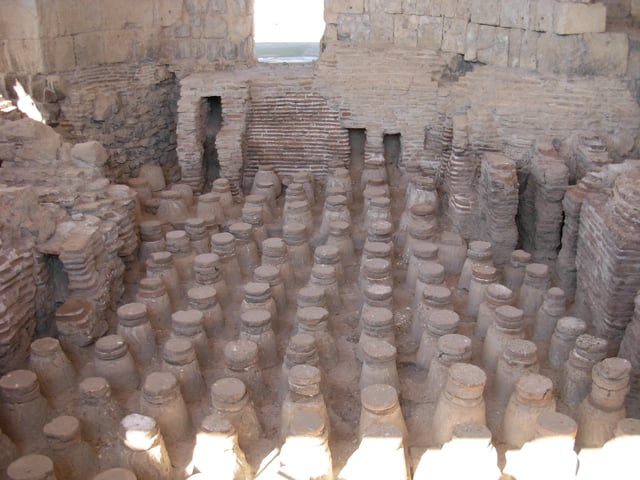
Roman baths
In 63 BCE, Pompey made Judea a part of the Roman empire. Beit She'an was refounded and rebuilt by Gabinius.[26] The town center shifted from the summit of the mound, or tell, to its slopes. Scythopolis prospered and became the leading city of the Decapolis, the only one west of the Jordan River.[27]
The city flourished under the "Pax Romana", as evidenced by high-level urban planning and extensive construction, including the best preserved Roman theatre of ancient Samaria, as well as a hippodrome, a cardo and other trademarks of the Roman influence. Mount Gilboa, 7 km (4 mi) away, provided dark basalt blocks, as well as water (via an aqueduct) to the town. Beit She'an is said to have sided with the Romans during the Jewish uprising of 66 CE.[26] Excavations have focused less on the Roman period ruins, so not much is known about this period. The Penn. University Museum excavation of the northern cemetery, however, did uncover significant finds. The Roman period tombs are of the loculus type: a rectangular rock-cut spacious chamber with smaller chambers (loculi) cut into its side.[23] Bodies were placed directly in the loculi, or inside sarcophagi which were placed in the loculi. A sarcophagus with an inscription identifying its occupant in Greek as "Antiochus, the son of Phallion", may have held the cousin of Herod the Great.[23] One of the most interesting Roman grave finds was a bronze incense shovel [88] with the handle in the form of an animal leg, or hoof, now in the University of Pennsylvania Museum.[28]
Byzantine period
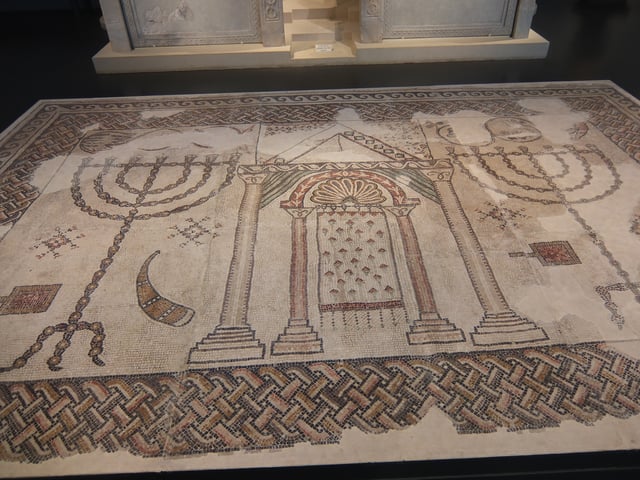
Mosaic from 5th-7th century synagogue in northern Beit Shean, possibly Samaritan (Israel Museum)[29]
Copious archaeological remains were found dating to the Byzantine period (330–636 CE) and were excavated by the University of Pennsylvania Museum from 1921–23. A rotunda church was constructed on top of the Tell and the entire city was enclosed in a wall.[30] Textual sources mention several other churches in the town.[30] Beit She'an was primarily Christian, as attested to by the large number of churches, but evidence of Jewish habitation and a Samaritan synagogue indicate established communities of these minorities. The pagan temple in the city centre was destroyed, but the nymphaeum and Roman baths were restored. Many of the buildings of Scythopolis were damaged in the Galilee earthquake of 363, and in 409 it became the capital of the northern district, Palaestina Secunda.[25] As such, Scythopolis (v.) also became the Metropolitan archdiocese of the province.
Dedicatory inscriptions indicate a preference for donations to religious buildings, and many colourful mosaics, such as that featuring the zodiac in the Monastery of Lady Mary, or the one picturing a menorah and shalom in the House of Leontius' Jewish synagogue, were preserved. A Samaritan synagogue's mosaic was unique in abstaining from human or animal images, instead utilising floral and geometrical motifs. Elaborate decorations were also found in the settlement's many luxurious villas, and in the 6th century especially, the city reached its maximum size of 40,000 and spread beyond its period city walls.[25]
The Byzantine period portion of the northern cemetery was excavated in 1926. The tombs from this period consisted of small rock-cut halls with vaulted graves on three sides.[31] A great variety of objects were found in the tombs, including terracotta figurines possibly depicting the Virgin and Child, many terracotta lamps, glass mirrors, bells, tools, knives, finger rings, iron keys, glass beads, bone hairpins, and many other items.[31]
Important Christian personalites who lived or passed through Byzantine Scythopolis are St Procopius of Scythopolis (died July 7, 303 AD), Cyril of Scythopolis (ca. 525–559), St Epiphanius of Salamis (c. 310/320 – 403) and Joseph of Tiberias (c. 285 – c. 356) who met there around the year 355.
Early Muslim period
In 634, Byzantine forces were defeated by the Muslim army of Caliph Umar ibn al-Khattab and the city reverted to its Semitic name, being named Baysan in Arabic. The day of victory came to be known in Arabic as Yawm Baysan or "the day of Baysan."[2] The city was not damaged and the newly arrived Muslims lived together with its Christian population until the 8th century, but the city declined during this period. Structures were built in the streets themselves, narrowing them to mere alleyways, and makeshift shops were opened among the colonnades. The city reached a low point by the 8th century, witnessed by the removal of marble for producing lime, the blocking off of the main street, and the conversion of a main plaza into a cemetery.[32] However, some recently discovered counter-evidence may be offered to this picture of decline. In common with state-directed building work carried out in other towns and cities in the region during the 720s,[33] Baysan's commercial infrastructure was refurbished: its main colonnaded market street, once thought to date to the sixth century, is now known—on the basis of a mosaic inscription—to be a redesign dating from the time of the Umayyad caliph Hisham (r. 724–43).[34] Abu Ubayd al-Andalusi noted that the wine produced there was delicious.[2]
On January 18, 749, Umayyad Baysan was completely devastated by a catastrophic earthquake. A few residential neighborhoods grew up on the ruins, probably established by the survivors, but the city never recovered its magnificence. The city center moved to the southern hill where later the Crusaders built their castle.[35]
Jerusalemite historian al-Muqaddasi visited Baysan in 985, during Abbasid rule and wrote that it was "on the river, with plentiful palm trees, and water, though somewhat heavy (brackish.)" He further noted that Baysan was notable for its indigo, rice, dates and grape syrup known as dibs.[36] The town formed one of the districts (kurah) of Jund al-Urdunn during this period.[37] Its principal mosque was situated in the center of its marketplace.[38]
Crusader period
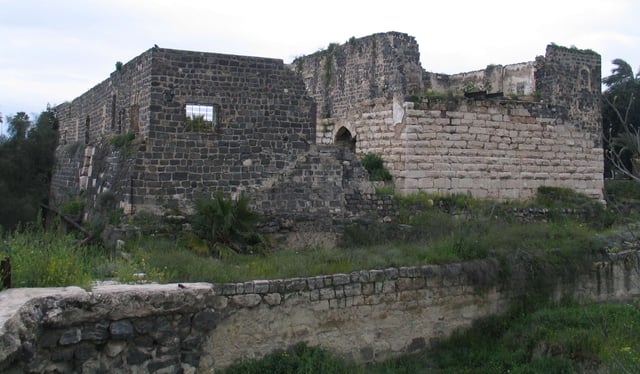
Crusader castle with moat and inner tower.
In the Crusader period, the Lordship of Bessan was occupied by Tancred in 1099; it was never part of the Principality of Galilee, despite its location, but became a royal domain of the Latin Kingdom of Jerusalem in 1101, probably until around 1120. According to the Lignages d'Outremer, the first Crusader lord of Bessan once it became part of the Kingdom of Jerusalem was Adam, a younger son of Robert III de Béthune, peer of Flanders and head of the House of Bethune. His descendants were known by the family name de Bessan.[39]
It occasionally passed back under royal control until new lords were created, becoming part of the Belvoir fiefdom.[40]
During the 1260 Battle of Ain Jalut, retreating Mongol forces passed in the vicinity but did not enter the town itself.
Mamluk period
Under Mamluk rule, Beit She'an was the principal town in the district of Damascus and a relay station for the postal service between Damascus and Cairo. It was also the capital of sugar cane processing for the region. Jisr al-Maqtu'a, "the truncated/cut-off bridge", a bridge consisting of a single arch spanning 25 feet and hung 50 feet above a stream, was built during that period.[42]
Ottoman period
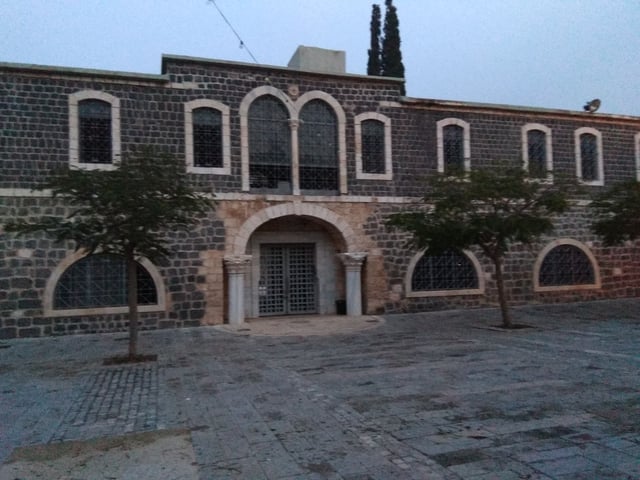
Ottoman Saraya
During this period the inhabitants of Beit She'an were mainly Muslim. There were however some Jews. For example, the 14th century topographer Ishtori Haparchi settled there and completed his work Kaftor Vaferach in 1322, the first Hebrew book on the geography of Palestine.[43]
During the 400 years of Ottoman rule, Baysan lost its regional importance. During the reign of Sultan Abdul Hamid II when the Jezreel Valley railway, which was part of the Haifa-Damascus extension of the Hejaz railway was constructed, a limited revival took place. The local peasant population was largely impoverished by the Ottoman feudal land system which leased tracts of land to tenants and collected taxes from them for their use.[2]
The Swiss–German traveler Johann Ludwig Burckhardt described Beisan in 1812 as "a village with 70 to 80 houses, whose residents are in a miserable state." In the early 1900s, though still a small and obscure village, Beisan was known for its plentiful water supply, fertile soil, and its production of olives, grapes, figs, almonds, apricots, and apples.[2]
British Mandate period
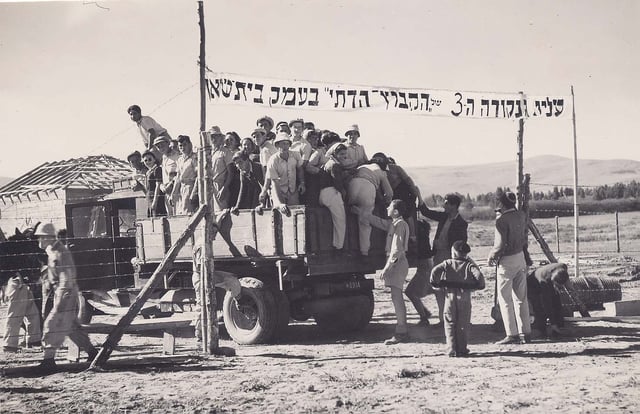
Pioneers of Kibbutz Ein Hanatziv settle in Bet She'an, 1946
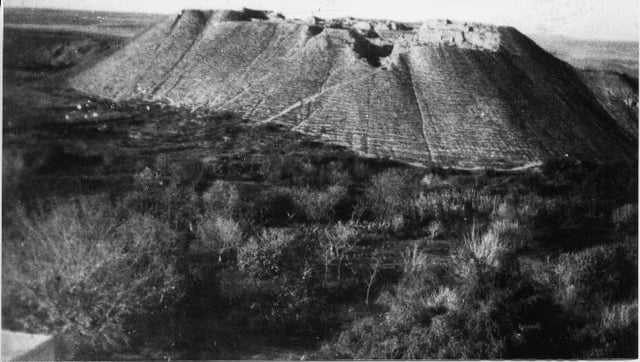
Beit She'an, the tell c. 1948
Under the Mandate, the city was the center of the District of Baysan. According to a census conducted in 1922 by the British Mandate authorities, Beit She'an (Baisan) had a population of 1,941, consisting of 1,687 Muslims, 41 Jews and 213 Christians.[44]
In 1934, Lawrence of Arabia noted that "Bisan is now a purely Arab village," where "very fine views of the river can be had from the housetops." He further noted that "many nomad and Bedouin encampments, distinguished by their black tents, were scattered about the riverine plain, their flocks and herds grazing round them."[2] Beisan was home to a mainly Mizrahi Jewish community of 95 until 1936, when the 1936–1939 Arab revolt saw Beisan serve as a center of Arab attacks on Jews in Palestine.[43][45][46] In 1938, after learning of the murder of his close friend and Jewish leader Haim Sturmann, Orde Wingate led his men on an offensive in the Arab section of Baysan, the rebels’ suspected base.[47]
According to population surveys conducted in British Mandate Palestine, Beisan consisted of 5,080 Muslim Arabs out of a population of 5,540 (92% of the population), with the remainder being listed as Christians.[48] In 1945, the surrounding District of Baysan consisted of 16,660 Muslims (67%), 7,590 Jews (30%), and 680 Christians (3%); and Arabs owned 44% of land, Jews owned 34%, and 22% constituted public lands. The 1947 UN Partition Plan allocated Beisan and most of its district to the proposed Jewish state.[2][49][50]
Jewish forces and local Bedouins first clashed during the 1948 Arab-Israeli War in February and March 1948, part of Operation Gideon,[2] which Walid Khalidi argues was part of a wider Plan Dalet.[51] Joseph Weitz, a leading Yishuv figure, wrote in his diary on May 4, 1948 that, "The Beit Shean Valley is the gate for our state in the Galilee...[I]ts clearing is the need of the hour."[2]
Beisan, then an Arab village, fell to the Jewish militias three days before the end of the Mandate.
State of Israel
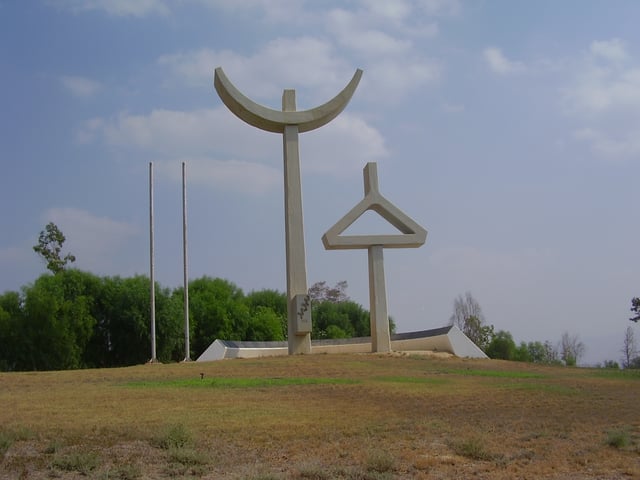
War monument, Al Mansfeld, 1960
After Israel's Declaration of Independence in May 1948, during intense shelling by Syrian border units, followed by the recapture of the valley by the Haganah, the Arab inhabitants fled across the Jordan River.[52] The property and buildings abandoned after the conflict were then held by the State of Israel.[2] Most Arab Christians relocated to Nazareth. A ma'abarah (refugee camp) inhabited mainly by North African Jewish refugees[53] was erected in Beit She'an, and it later became a development town.
Beit She'an was the hometown and political power base of David Levy, a prominent figure in Israeli politics.
During the Second Intifada, in the 2002 Beit She'an attack, six Israelis were killed and over 30 were injured by two Palestinian militants, who opened fire and threw grenades at a polling station in the center of Bet She'an where party members were voting in the Likud primary.
Archaeology and tourism
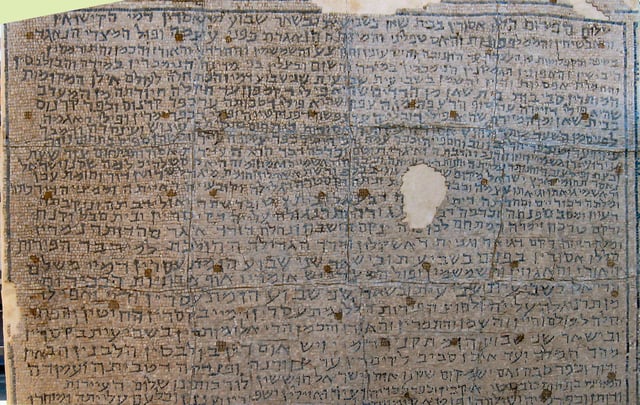
Rehov inscription
The University of Pennsylvania carried out excavations of ancient Beit She'an in 1921–1933. Relics from the Egyptian period were discovered, most of them now exhibited in the Rockefeller Museum in Jerusalem. Some are in the University of Pennsylvania Museum in Philadelphia.[57] Excavations at the site were resumed by the Hebrew University of Jerusalem in 1983 and then again from 1989 to 1996 under the direction of Amihai Mazar.[58] The excavations have revealed no less than 18 successive ancient towns.[59][60] Ancient Beit She'an, one of the most spectacular Roman and Byzantine sites in Israel, is a major tourist attraction.[61] The seventh century Mosaic of Rehob was discovered by farmers of Kibbutz Ein HaNetziv. Part of a mosaic floor, it contains details of Jewish religious laws concerning tithes and the Sabbatical Year.[62]
Earthquakes
Beit She'an is located above the Dead Sea Transform (a fault system that forms the transform boundary between the African Plate to the west and the Arabian Plate to the east) and is one of the cities in Israel most at risk to earthquakes (along with Safed, Tiberias, Kiryat Shmona and Eilat).[63] Historically, the city was destroyed in the Golan earthquake of 749.
Demographics
According to the Israel Central Bureau of Statistics (CBS), the population of the municipality was 18,227 at the end of 2018.[1] In 2005, the ethnic makeup of the city was 99.5% Jewish and other non-Arab (97.3% Jewish), with no significant Arab population. See Population groups in Israel. The population breakdown by gender was 8,200 males and 8,100 females.[64]
The age distribution was as follows:
| Age | 0–4 | 5–9 | 10–14 | 15–19 | 20–29 | 30–44 | 45–59 | 60–64 | 65–74 | 75+ |
|---|---|---|---|---|---|---|---|---|---|---|
| Percentage | 9.9 | 9.4 | 9.4 | 9.4 | 17.6 | 17.7 | 16.7 | 2.7 | 4.4 | 2.8 |
| Source: Israel Central Bureau of Statistics[64] | ||||||||||
Economy
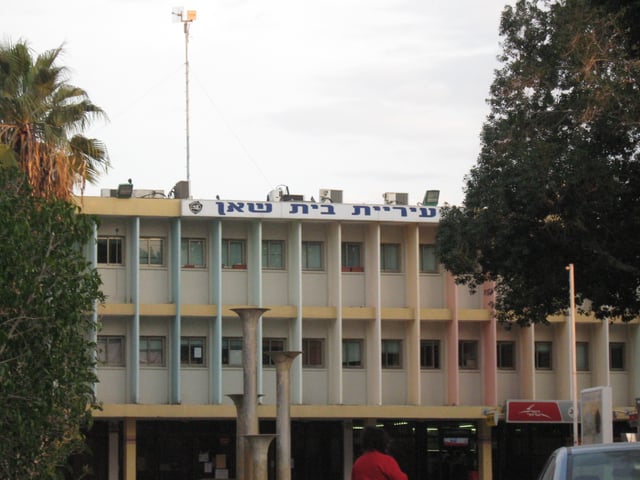
Beit She'an municipality
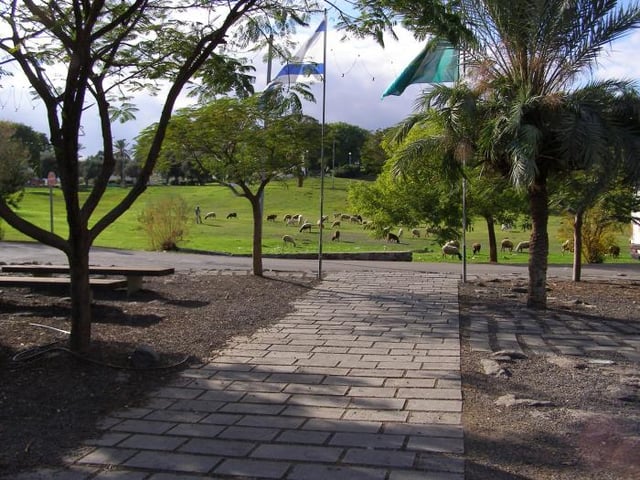
Beit She'an park
When the ancient city of Beit She'an was opened to the public in the 1990s and turned into a national park, tourism became a major sector of the economy.[65]
Education
According to CBS, there are 16 schools and 3,809 students in the city. They are spread out as 10 elementary schools and 2,008 elementary school students, and 10 high schools and 1,801 high school students. 56.2% of 12th grade students were entitled to a matriculation certificate in 2001.
Transportation
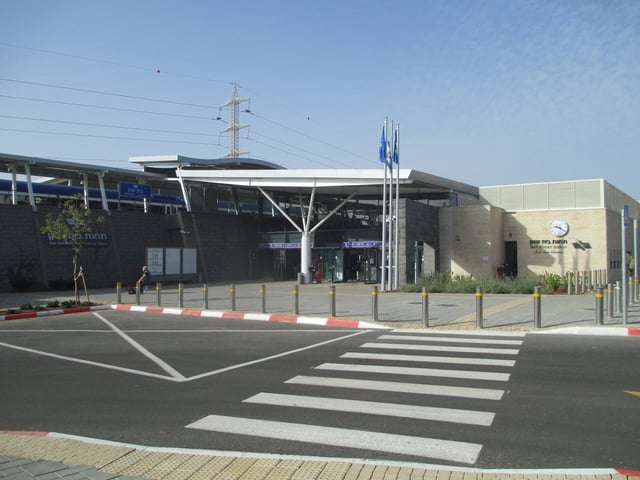
New railway station, Beit She'an
Beit She'an had a railway station that opened in 1904 on the Jezreel Valley railway which was an extension of the Hejaz railway. This station closed together with the rest of the Jezreel Valley railway in 1948. In 2011–2016 the valley railway was rebuilt and the new Beit She'an Railway Station, located at the same site as the historical station was opened. Passenger service offered at the station connects the city to Afula, Haifa and destinations in between. In addition to passenger service, the station also includes a freight rail terminal.
Sports
The local football club, Hapoel Beit She'an spent several seasons in the top division in the 1990s, but folded in 2006 after several relegations. Maccabi Beit She'an currently plays in Liga Bet.
Notable residents
Ishtori Haparchi
David Levy (Israeli politician)
Orly Levy
Jackie Levy
Twin towns – sister cities
Beit She'an is twinned with:
[[INLINE_IMAGE|//upload.wikimedia.org/wikipedia/en/thumb/a/a4/Flag_of_the_United_States.svg/23px-Flag_of_the_United_States.svg.png|//upload.wikimedia.org/wikipedia/en/thumb/a/a4/Flag_of_the_United_States.svg/35px-Flag_of_the_United_States.svg.png 1.5x, //upload.wikimedia.org/wikipedia/en/thumb/a/a4/Flag_of_the_United_States.svg/46px-Flag_of_the_United_States.svg.png 2x|United States|h12|w23|thumbborder flagicon-img flagicon-img]] Cleveland, United States (Since 2019)[66]
Historic images
See also
List of Arab towns and villages depopulated during the 1948 Arab-Israeli War
Vassals of the Kingdom of Jerusalem
Sheikh Hussein Bridge


